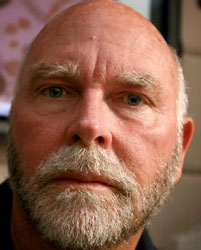 The news that J. Craig Venter had made lemonade out of lemons or rather diploids out of haploids, and beaten back the well-endowed consortium which had first claimed victory in mapping the human genome came in a wave of gotcha back-to-school hyperbole.
The news that J. Craig Venter had made lemonade out of lemons or rather diploids out of haploids, and beaten back the well-endowed consortium which had first claimed victory in mapping the human genome came in a wave of gotcha back-to-school hyperbole.
Before I go much further with this analysis, I just want to say that though I took biology twice, once in seventh grade (where I was escorted to the nurse's office from the classroom by my lab partner who had watched me go green after the frog dissection) and once as a freshman in college (when despite the aid of various pharmaceuticals I persisted in getting Cs on my exams), I get pretty dreamy when I read about this stuff. The graphics are beautiful: wiggly looking inchworm-y things, which are supplemented by color charts that look like Venter was channeling Mondrian as he boogie woogied his way through the sequencing and they hold my attention for a while but then I get horribly confused about the base pairs and the 44% variation now noticeable between what he inherited from his mother and his father and the reads and alleles and snps and indeles... and well, you detect my genetic drifting which I'm sure will they will duly number and codify when they get to non-science types like me.
People seem to be put off by Venter's ego -- having used himself as guinea pig to stave off privacy issues -- but this auto-experimentation falls within historical norms of how scientists, and artists and well just about everybody makes progress on their pet projects. It's the cheapest, most expedient way to go.
But the thing that intrigues me most is the numbering and naming of the genes as they are linked to specific traits and which though you can detect the copywriting of scientists in their rather dry formulations still have their titillating side peeking through. Though we live in a time when everybody blames their genes for their bad girl (and boy) behavior and when we can hide behind sequencing as we act out at work or play, it's still amazing to think with one little spec of DNA we can potentially be outed as we really are.
I know people are very worried about this for all kinds of good reasons including being declared ineligible for certain insurance and as distractions from habeus corpus in a court of law besides the fact that the interplay between genes and nurture can have a powerful effect -- there's no science that states you have to express the trait that you have inherited through no fault of your own.
This is old news to many of you who follow the bouncing genome. But for the rest of us layfolks, the ingeniousness of it all can still be mind-bending. Seemingly as simple as scanning a grocery store barcode, Dr. Venter's genes were clearly identified and named. Naturally I homed right in on the ones which seemed might have personal application. The easy ones are the externals: OCA2 for blue eyes and fair skin and even the internals, things like TNFSF4 or NOS3 which deal with a history of family coronary disease or PER2 and Clock which deal with evening preferences and sleep since I'm a notorious insomniac.
But the ones that are the most incendiary are the ones that deal with behaviors -- you mean that feistiness that everyone remarks on is all because of MAOA? Or, my favorite, DRD4, the so-called novelty seeking personality gene which begins to sound like Billy Wilder's Seven Year Itch has finally been validated scientifically once and for all.
How did they arrive at this? I thought you had to isolate genes to figure them out, and how do you do that for the Party Gene which depends on mixing it up? What did Dr. Venter, or Craig as he's known to his remaining friends who haven't been put off by his antisocial, tobacco and alcohol addicted, night owl, running-around type behavior, do to prove ownership of the traits on these tiny sperm-like squiggles? Somebody who got an A in Bio is going to have to fill me in.
The photo of Dr. Venter in the New York Times displays his intensity and it looks like maybe he had just pulled an all-nighter and was recovering from too much DRD4, SLSC6A3 and CHRNA6. (Lucky for him we couldn't see the brown, sticky, wet earwax -- ABCC11 -- he's also seemingly afflicted with: this gene mapping can be very sexy as long as we don't get into the details of personal hygiene.)
Venter is still accepting outside applicants for some studies on insomnia and heart disease and I guess I could always apply for those. But I think it's worth waiting for the Novelty Seeking Personality study which I am sure will be a lot more fun.